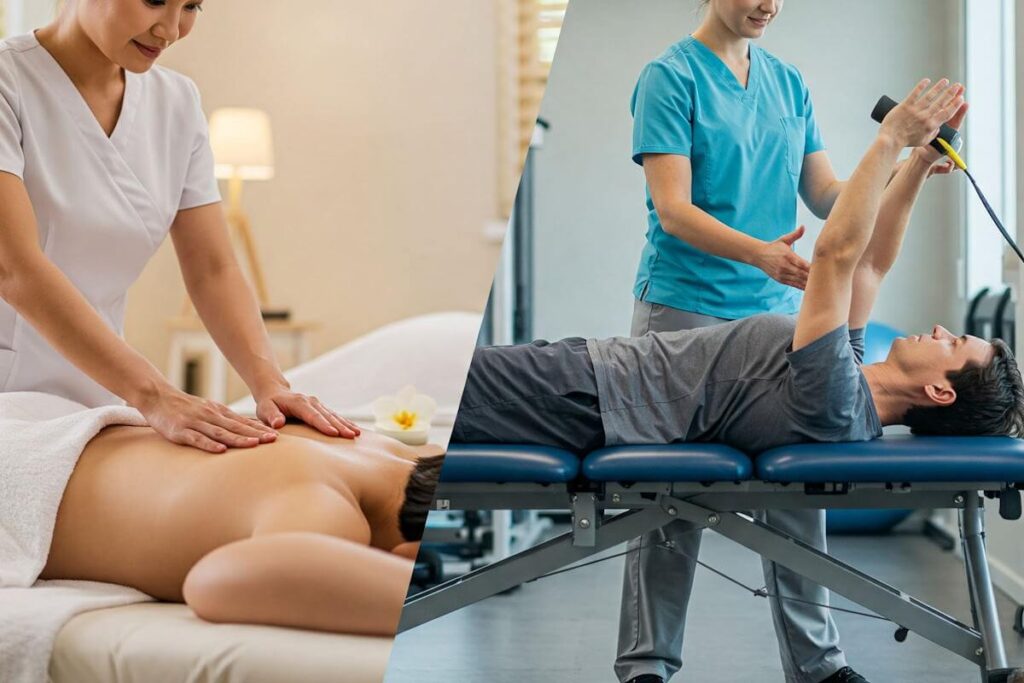Introduction
In the realm of healthcare, massage therapy and physical therapy are two distinct practices that often evoke confusion among patients. Both modalities aim to alleviate pain and enhance physical function, yet they serve different purposes and are grounded in unique principles. As individuals seek relief from discomfort and a pathway to recovery, understanding the differences between these two therapies becomes paramount. This clarity not only aids in the selection of the appropriate treatment option but also fosters informed discussions with healthcare professionals.
Massage therapy primarily focuses on manipulating soft tissues, including muscles, ligaments, and tendons, to promote relaxation, reduce tension, and improve circulation. The emphasis is on enhancing overall well-being and providing relief from stress-related symptoms. On the other hand, physical therapy is a more comprehensive approach that employs various techniques, including exercises, stretches, and specialized equipment, to rehabilitate injuries and improve functional mobility. Physical therapists assess patients’ conditions and develop tailored treatment plans to address specific limitations or injuries.
Common misconceptions regarding the equivalency of these therapies often lead patients to underestimate the importance of seeking the right treatment for their specific conditions. While there are overlapping benefits, particularly in muscle relaxation and pain relief, the underlying objectives differ significantly. For instance, a physical therapist may utilize massage techniques as part of a broader therapeutic strategy to enhance rehabilitation outcomes. Conversely, a massage therapist may not be equipped to address the complex rehabilitation needs seen in patients recovering from surgery or injury.
Ultimately, both massage therapy and physical therapy play vital roles in the spectrum of healthcare. Acknowledging their differences not only assists patients in making informed choices but also encourages effective collaboration between different healthcare practitioners, enhancing the overall treatment landscape and improving patient outcomes.
What is Massage Therapy?
Massage therapy is a comprehensive practice that involves the manipulation of soft tissues in the body, primarily the muscles, tendons, and fascia. This age-old technique aims to promote relaxation, alleviate pain, and enhance the overall sense of well-being. There are numerous types of massage therapy, each designed to cater to varying needs and preferences. Some popular forms include Swedish massage, deep tissue massage, hot stone therapy, and sports massage, among others. Each technique employs a unique approach, but they share a common goal: to provide relief and therapeutic benefits to individuals.
Massage therapy works by engaging the body’s natural healing processes. The pressure applied during a massage can increase blood flow, which in turn improves circulation and aids in the delivery of essential nutrients to the tissues. This enhanced circulation not only supports physical recovery but also has the potential to help with mental clarity and stress reduction. As individuals experience relaxation, they often report a decrease in anxiety and improved mood, highlighting the dual benefits of massage therapy on physical and mental health.
Additionally, various techniques used in massage therapy can target specific areas and conditions. For instance, deep tissue massage focuses on realigning deeper layers of muscles and connective tissue, which can be beneficial for chronic pain and injury rehabilitation. Conversely, Swedish massage employs lighter strokes to promote relaxation and relieve tension. Overall, massage therapy is a versatile modality that can be adapted to suit the diverse needs of clients, illustrating its importance in both preventive health and therapeutic settings.
What is Physical Therapy?
Physical therapy (PT) is a healthcare specialty focused on the evaluation, treatment, and rehabilitation of individuals with physical impairments or disabilities. Essentially, it aims to restore function, improve movement, alleviate pain, and enhance the overall quality of life for patients. The primary goal is to help individuals recover from injuries, surgeries, or chronic conditions, enabling them to return to their daily activities and improve their physical performance.
PT employs a diverse range of methods and techniques, including exercises, manual therapy, electrotherapy, and education on body mechanics. Physical therapists assess each patient’s condition thoroughly, develop individualized treatment plans, and guide them through tailored exercises and activities designed to promote healing. The approach is highly personalized, often integrating the patient’s goals, preferences, and unique physical challenges into the rehabilitation process.
The types of conditions addressed through physical therapy are numerous and encompass various aspects of health. These include musculoskeletal injuries, neurological disorders, cardiovascular issues, and pre- and post-operative recovery. For example, individuals recovering from joint surgery may benefit from targeted exercises and stretching to regain strength and flexibility, while those with stroke-related impairments may require specialized therapies to enhance mobility and coordination. Furthermore, physical therapists play a crucial role in injury prevention by educating patients on proper techniques, ergonomics, and fitness regimens that promote physical health and reduce the risk of future injuries.
Ultimately, the effectiveness of physical therapy lies in its holistic approach to treatment, addressing not only the physical symptoms but also the emotional and psychological components of recovery. This comprehensive methodology helps empower patients, providing them with tools and techniques to manage their health long-term, fostering resilience and independence in their physical well-being.
Key Differences Between Massage and Physical Therapy
Massage therapy and physical therapy serve distinct purposes in the realm of healthcare, though both aim to improve physical well-being. Understanding their key differences can help individuals make informed decisions about their treatment options.
The primary objective of massage therapy is to alleviate muscle tension and promote relaxation. Through techniques such as kneading, tapping, and stroking, massage therapists manipulate soft tissue to enhance circulation and reduce stress. This treatment is often used for stress relief, injury recovery, and maintenance of overall wellness. Conversely, physical therapy focuses on rehabilitation and restoring functional movement following an injury or surgery. Physical therapists employ specific exercises, modalities, and manual techniques to address musculoskeletal dysfunctions and enhance mobility.
In terms of techniques, massage therapy emphasizes various hands-on approaches that vary widely in style, such as Swedish, deep tissue, and sports massage. Each style can cater to individual client needs, whether for relaxation or targeted pain relief. On the other hand, physical therapy utilizes a structured approach, often integrating therapeutic exercises with strength training, stretching, and sometimes electrotherapy, ultrasound, or other modalities. This evidence-based practice is geared towards achieving measurable recovery goals.
The settings for these therapies also differ markedly. Massage therapy is commonly practiced in spas, wellness centers, and private practices, where clients seek out the service for relaxation and enjoyment. In contrast, physical therapy is typically conducted in clinics or rehabilitation centers, often under physician referral, following specific medical guidelines. The environments are more clinical and may include diagnostic assessments to tailor treatments effectively.
Finally, the qualifications of practitioners differ. Massage therapists generally complete specialized training and obtain state licenses. In contrast, physical therapists hold advanced degrees in physical therapy and must pass national licensing examinations. Their educational background equips them with a deeper understanding of anatomy and pathology, allowing them to create targeted rehabilitation programs.
When to Choose Massage Therapy
Massage therapy serves a wide range of purposes, making it an appealing option for many individuals seeking relief from various physical and mental conditions. One of the primary scenarios in which massage therapy can be beneficial is during periods of heightened stress. Modern life often leads to increased tension and anxiety; massage therapy provides a holistic approach to easing stress, encouraging relaxation, and promoting emotional well-being. The gentle manipulation of tissues can stimulate the release of endorphins, naturally enhancing one’s mood.
Another situation that presents a compelling case for massage therapy is muscle tension. This condition often arises from overexertion, improper posture, or sedentary lifestyles. Individuals who experience chronic muscle soreness or tension in specific areas, such as the neck, shoulders, or back, may find that targeted massage techniques can alleviate discomfort and restore balance. Techniques such as deep tissue massage or trigger point therapy can effectively break down knots in the muscles, leading to improved mobility and reduced pain.
Moreover, massage therapy can also cater to those seeking general wellness. Many individuals incorporate regular massage sessions into their routine as a preventative measure, aiming to maintain physical health and overall well-being. Athletes and physically active individuals, in particular, benefit significantly from scheduled massage therapy, which aids in muscle recovery and injury prevention.
Lastly, massage therapy can be of particular advantage for individuals who may prefer a non-invasive treatment route, or for those who wish to complement other medical interventions. It is essential to recognize that while it may not replace traditional medical approaches, it can serve as a valuable ally in achieving a holistic health goal. Therefore, when considering options for stress relief, muscle tension, or general wellness, massage therapy presents a compelling choice for many individuals.
When to Choose Physical Therapy
Physical therapy is a specialized form of rehabilitation that is particularly effective for a range of conditions affecting movement, pain management, and recovery. Choosing physical therapy over massage therapy is often warranted in situations such as chronic pain, post-surgical recovery, and mobility issues. Individuals experiencing ongoing discomfort related to conditions like arthritis, fibromyalgia, or other chronic pain syndromes can significantly benefit from the focused approach offered by physical therapists. These professionals employ various techniques including exercise rehabilitation, manual therapy, and modalities to alleviate pain and enhance function.
Furthermore, post-surgical recovery frequently requires the expertise of a physical therapist. Following surgeries, especially orthopedic procedures such as joint replacements or repair of soft tissue injuries, a tailored physical therapy plan is crucial for restoring strength, stability, and mobility. Physical therapists assess the specific surgical procedure, the patient’s overall health, and recovery goals to create a customized rehabilitation program aimed at a safe and effective return to daily activities.
Mobility issues can also signal the need for physical therapy intervention. Conditions resulting from injuries, neurological disorders, or degenerative conditions can lead to significant impairments in movement. Physical therapists employ assessment tools to evaluate functional limitations, balance, strength, and range of motion. Based on these evaluations, they design programs that not only address the immediate concerns but also aim to prevent future injuries through strength and flexibility training.
In conclusion, physical therapy is essential in managing chronic pain, facilitating post-surgical recovery, and improving mobility. By engaging a licensed physical therapist, individuals can ensure they receive a structured and informed approach to their treatment, ultimately resulting in better health outcomes.
Combining Massage and Physical Therapy
Integrating massage therapy with traditional physical therapy can yield significant benefits for patients seeking relief from various musculoskeletal issues. Both modalities offer unique approaches to healing, yet when combined, they provide a holistic strategy that addresses both the symptoms and the underlying causes of pain and discomfort. Massage therapy is primarily focused on soft tissue manipulation, aiming to enhance blood circulation, reduce muscle tension, and promote relaxation. In contrast, physical therapy emphasizes rehabilitative exercises and techniques designed to restore movement and function to affected areas.
One of the primary advantages of combining these therapies is the potential for improved outcomes in treatment plans. For instance, a patient recovering from an injury may begin their journey with physical therapy to strengthen the muscles surrounding the injured area. Once the initial pain subsides, incorporating massage can enhance the healing process by relaxing tight muscles that may impede recovery. Through this collaboration, patients often experience quicker relief and increased mobility, allowing them to return to their daily activities more efficiently.
Successful integration of massage therapy and physical therapy relies heavily on effective communication between healthcare providers. When practitioners from both fields share insights regarding patient progress and treatment plans, they can create a more cohesive approach tailored to individual needs. This collaborative effort can help ensure that treatment strategies are not only complementary but also address any lingering issues that may arise during recovery. In doing so, patients benefit from a comprehensive treatment plan that maximizes the advantages of both modalities.
Incorporating both massage and physical therapy into a single treatment approach not only enhances rehabilitation outcomes but also empowers patients to take an active role in their wellness journey. By understanding the unique contributions of each modality and fostering a cooperative environment among healthcare providers, patients can achieve a balanced and effective path to recovery.
Conclusion
In summary, understanding the differences between massage and physical therapy is crucial for individuals seeking effective treatments for various health conditions. While both modalities play significant roles in promoting physical well-being, they serve distinct purposes and employ different techniques. Massage therapy primarily focuses on alleviating muscle tension, improving relaxation, and enhancing overall wellness through the manipulation of soft tissues. On the other hand, physical therapy is a comprehensive approach that involves personalized rehabilitation plans, aimed at restoring function, optimizing mobility, and addressing specific injuries or ailments.
It is essential for individuals to assess their unique health needs when deciding between these two forms of treatment. Those experiencing chronic pain, recovering from surgery, or managing specific injuries may benefit more from the structured approach that physical therapy provides. Conversely, individuals looking for relaxation and relief from stress or minor tension may find massage therapy more beneficial. Consulting with qualified healthcare professionals can facilitate this decision-making process.
Ultimately, both massage and physical therapy can complement one another, allowing individuals to create a holistic approach to their health and recovery. Recognizing the nuances and core objectives of each treatment modality empowers individuals to make informed decisions regarding their wellness journey. Whether opting for the soothing touch of a massage or the targeted interventions of physical therapy, a well-rounded understanding will ensure a more tailored and effective treatment experience.
Additional Resources
For those interested in learning more about massage therapy and physical therapy, there are a variety of resources available that can provide valuable information and guidance. Professional organizations such as the American Massage Therapy Association (AMTA) and the American Physical Therapy Association (APTA) offer extensive resources for both practitioners and consumers. These organizations provide educational materials, certification guidelines, and a directory of qualified therapists you can consult in your area.
Moreover, there are numerous books and online publications dedicated to both massage and physical therapy. Titles like “The Massage Book” by Hugh Milne and “The Concise Book of Muscles” by Chris Jarmey offer insightful perspectives on techniques and anatomy. Academic journals focusing on rehabilitation or alternative medicine may also offer evidence-based research on the efficacy of various therapies.
Finding a qualified therapist is essential for achieving the desired outcomes from either massage or physical therapy. Websites such as MassageFinder.com and TherapySpot.com allow you to search for qualified practitioners based on specific criteria, including location and specialty. When selecting a therapist, it is advisable to check their credentials, reviews, and ensure they have proper licensing and certifications. This due diligence will contribute to a more informed therapeutic experience.
Additionally, many clinics and wellness centers provide introductory sessions, which can be a helpful way to gauge the therapist’s approach and see if it aligns with your therapeutic needs. Engaging with online forums or local support groups focused on chronic pain relief and wellness can also provide recommendations and shared experiences that might lead you to the right professional. Empowering yourself with knowledge and connecting with the right resources can significantly enhance your therapy journey.




